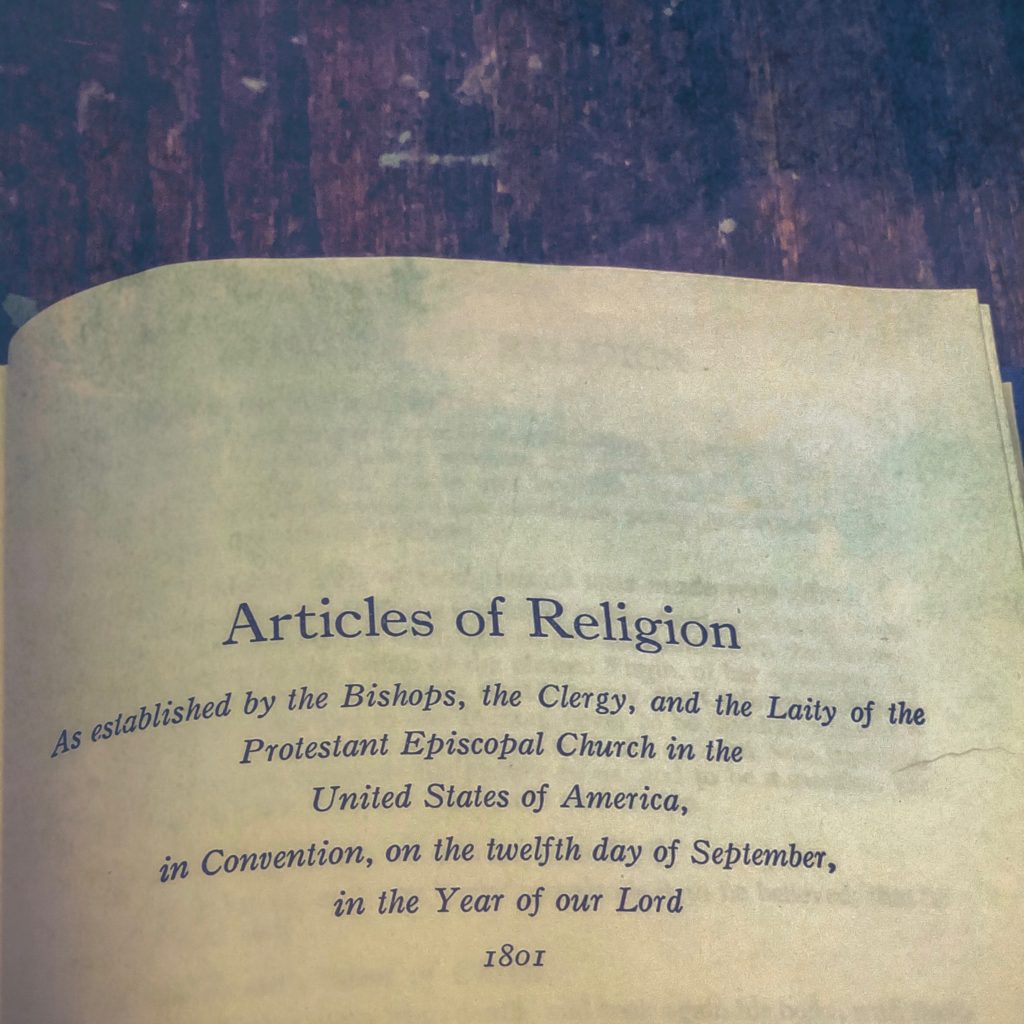
The Three Creeds, Nicene Creed, Athanasius’s Creed, and that which is commonly called the Apostles’ Creed, ought thoroughly to be received and believed: for they may be proved by most certain warrants of Holy Scripture.
by the Rev. Rakgadi Khobo
It is not uncommon to hear a member of the clergy refer to the creeds as being outdated or having no relevance for us today. In the province of Southern Africa, the primary creed in our Sunday worship is the Nicene Creed. The challenges and issues raised about the creed relate to the Nicene Creed. Most of those who have raised objections to the creeds have rarely spoken to the truths contained in the creeds. The objections relate to the latest fashions, the language of the creeds, and political correctness. To discard the creeds without having looked closely at the truths contained in the creeds would be akin to throwing the baby out with the bath water.
We have to begin somewhere in this task. The full title of the Articles of Religion provide some context to how we are to understand why these three creeds were chosen and not any other. The full title of the Thirty-Nine Articles reads as follows:
Articles Agreed upon by the Archbishops and Bishops of both Provinces, and the whole Clergy in the Convocation holden at London in the year 1562, for the avoiding of diversities of opinions and for the establishing of Consent touching true religion.
What is immediately clear from the title is that the bishops were looking to provide some guidance to the faithful, without necessarily being prescriptive in their guidance. The second thing that is clear in the title that helps explain why these three creeds were chosen is that the bishops wanted us to remain rooted in the true religion. This is not the place to go into detail about the true religion. The unity of the Church is protected by the Canons of the Ecumenical Councils, the rules of the Holy Fathers of the Church, and Holy Tradition. The existence of the Anglican church is not meant to contradict the unity of the Church. The separation in our visible organization does not prevent us from being spiritually larger members of the one body of the universal Church, or from sharing the one head, Christ, and the one spirit of faith and grace. This unity is given visible expression by a single confession of faith, in the creeds and by communion in prayer and the sacraments. Therefore, when the article says these creeds “ought thoroughly to be received and believed,” it is not just because the content of the creeds can be found in scripture. It is also because these creeds summarize the core beliefs of the universal Church.
All three creeds contains statements with regards to Christology, the filioque, the Father, and the Church. These statements should be understood as boundaries, rather than the path. These creeds did not come about because the early Church Fathers wanted to control what people believed. Rather, as time passed different places had different credal statements, all professing the identical faith yet using different forms and expressions, with different degrees of detail and emphasis. These credal forms usually became more detailed and elaborate in those areas where questions about the faith had arisen and heresies had developed.
This is because historically there were many theologies with regards to Christ and the Holy Spirit. Some threatened to tear the Church apart. The influence of politics on the early church councils should not be taken lightly, as it has had bearing on the creeds we have today. That being said, we cannot deny the gifts the creeds have been in helping us remain united, and connected to the true Church. In the creeds the early Church left us with a thread of unity in the creeds, a common profession of faith. This was important as it allowed the Church to expand.
“Ought thoroughly to be received and believed“
Article VIII falls under the category of Articles on the rule of faith. The three creeds mentioned in the article are the three ecumenical creeds accepted by the universal Church. The Nicene Creed was formally drawn up by the Church in 325 AD and 381 AD after great controversies developed in Christendom about the nature of the Son of God and the Holy Spirit.
A creed is a biblical account of faith, which involves knowledge, assent, and trust; indeed, these are three elements of a single act of faith involving the whole person who commits himself to God. This pertains to the importance of reason in engaging with the creeds. In the early Church there were many different forms of the Christian confession of faith; many different “creeds.” The need for theology and for the creeds arises from two basic facts. One is the nature of man as an intelligent being. To quote Anselm: “just because he is intelligens the Christian, of all men, has to learn to discern with agonizing clarity what is conceivable by him about God himself.” These creeds were always used originally in relation to baptism. Before being baptized a person had to state what he believed.
The creeds are part of our inheritance of faith. These creeds are historical and contextual by nature. What this means is that we cannot read into the creeds the knowledge and attitudes we have today, about faith, Jesus and God. Our judgment of the content and truths contained in the creeds needs to show respect for their historical context and social and cultural background, sensitivity for their grammatical and conceptual instrumentation, careful insights into the specific controversies in relation to which and the positions against which they were written in the first place.
The question before us is whether the theological truth-content of what is asserted in the creeds is exclusively tied to that setting. Take for example the following question from the Heidelberg Catechism:
Q. What is your only comfort in life and in death?
A. That I am not my own, but belong – body and soul, in life and in death – to my Saviour, Jesus Christ. He has fully paid for all my sins with his precious blood, and has set me free from sin. He also watches over me in such a way that not a hair can fall from my head without the will of my Father in heaven; in fact, all things must work together for my salvation. Because I belong to him, Christ, by his Holy Spirit, assures me of eternal life and makes me wholeheartedly willing and ready from now on to live for him.
From this brief example we see that the truth of the statements asserted in this catechism does not depend on when they were said or asserted. They would be true for men and women living at any time, and in any place.
That being said, the creeds are exclusive beliefs, such that because they assert truth, excluding some things as false, those who deny the truth of these propositions must be regarded as mistaken. We cannot change that the creeds are historical documents written in light of a specific controversy. They are polemical and antithetical, and all truth formulated for polemical reasons is partial. Yet however incomplete and inadequate, the truth is in the creeds. With regards to the truth of revelation, and however important understanding the extra-linguistic context is for understanding the asserted propositions in that context, they are nevertheless true insofar as they state absolutely nothing that is false.
The creeds are reflective of the struggles the Church had to overcome in its early years. With the expansion of the Church came the need for the Church to set boundaries, for the Church to streamline its teaching. In our world of connectedness and where truth seems to be relative, it is important to recognize that the truths contained in the creeds were true when they were written as they are still true today. The claim that once something is true it is always true, forever true, and unchangeably true is not inconsistent with finding new ways of expressing the truth of dogmas when the need arises.
Jaroslav Pelikan rightly sees that “underlying the creedal and conciliar definitions of orthodoxy from the beginning have been three shared presuppositions: first, that there is a straight line . . . from the Gospels to the creed; consequently, second, that the true doctrine being confessed by the councils and creeds of the church is identical with what the New Testament calls the ‘faith which was once for all delivered to the saints’ [Jude 3]; and therefore, third, that continuity with that faith is the essence of orthodoxy, and discontinuity with it the essence of heresy.”
The goal of the creeds is to confess this same faith if possible more clearly than before and to articulate possible misunderstandings, confusion and mistaken opinions more accurately than before. The articulation of faith in intelligible words not only clarifies faith but becomes itself the means of deeper commitment of heart and mind. This should be done with care and careful consideration not to change the truth contained in the creeds, for as the Article says, “they may be proved by most certain warrants of holy Scripture.”
The Rev. Rakgadi Khobo is a priest in the Anglican Church of Southern Africa.
On the website for St Cyril they have done a full analysis of the biblical references to every statement made in the creed.
